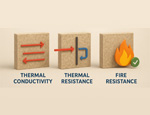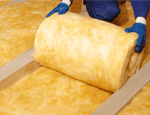- Blogs
- Sustainability in Insulation: Embodied Carbon, Recyclability & Circularity for Glass Wool and Stone Wool
Sustainability in Insulation: Embodied Carbon, Recyclability & Circularity for Glass Wool and Stone Wool

Creating buildings that are energy-efficient, sustainable, and ready for the future begins with selecting the right material for your project. Insulation is often one of the most overlooked yet powerful tools in achieving that vision. Thoughtfully designed glass wool and stone wool solutions bring together high thermal and acoustic performance with a remarkably low environmental footprint across their entire life cycle. Below is a closer look at how these materials perform on the three pillars that matter most in sustainable design: embodied carbon, recyclability, and circularity.
A. EMBODIED CARBON: LOW UPFRONT IMPACT, RAPID CARBON PAYBACK

- Material Origins
Glass Wool is produced primarily from sand and recycled glass cullet, while Stone Wool is manufactured from abundant natural rock (e.g., basalt/dolomite) with the ability to incorporate process and post-consumer mineral streams. Both are melted and fiberized in highly controlled, and heat-recovered manufacturing lines. Saint-Gobain’s continuous process optimization—energy recovery, process efficiency, and waste heat reuse—reduces process emissions per ton of fiber produced.
- Lightweight, High Performance Insulation
A defining sustainability advantage of mineral wool is its very high thermal resistance of the insulation. Because Glass Wool and Stone Wool deliver excellent lambda values, you achieve target U-values with less mass moved and installed. That typically translates into lower embodied carbon per unit of thermal performance, as well as lower transport emissions from plant to site.
Packaging methodology such as compressed packaging and bulls eye packaging enables more transportation of insulation per full truck load, reducing overall carbon footprint per unit of insulation.
- Long service life and carbon payback
The carbon “payback period” for mineral wool is typically short: insulation often saves multiples of its embodied CO₂ within the first heating/cooling seasons by reducing building energy demand. Over decades of operation, the cumulative operational carbon avoided dwarfs the initial manufacturing footprint, especially in hot-humid and mixed climates where cooling energy dominates.
- Transparency via EPDs
Saint-Gobain publishes third-party verified Environmental Product Declarations (EPDs) for its mineral wool insulation, developed to EN 15804/ISO 14025 standards. EPDs enable apples-to-apples comparisons and allow project teams to integrate insulation impacts into Whole-Building Life Cycle Assessment (WBLCA) and embodied-carbon.
B. RECYCLABILITY AND CIRCULARITY: DESIGNED FOR SUSTAINABILITY

- High recycled content and upcycling of by-products
Glass Wool typically contains a high share of recycled glass cullet, diverting waste from landfills and reducing the need for fresh raw materials. In manufacturing, trim waste is routinely captured and fed back into the process for minimal wastage.
- Durability that protects circular value
Both Glass Wool and Stone Wool are dimensionally stable, moisture-resistant when properly detailed, and non-corrosive to building elements. Their long service life preserves performance over decades, reducing replacement cycles and associated waste. For Stone Wool, high compressive strength and robustness in demanding assemblies (e.g., façades, roofs, industrial) further enhance circular value by keeping materials in service longer.
- Responsible Packaging
Saint-Gobain optimizes packaging volumes through compression technology and increasingly leverages recyclable film and returnable pallets, reducing transport emissions and site waste while simplifying end-of-project waste management.
C. CERTIFICATION & COMPLIANCE: PROOF OF PERFORMANCE AND SUSTAINABILITY
- Biosolubility & Health Safety
Saint-Gobain Glass Wool and Stone Wool fibers are designed to be biosoluble, and products are independently recognized by EUCEB (European Certification Board of Mineral Wool Products) for compliance with stringent bio solubility criteria. This addresses worker safety during installation and supports healthier interiors when products are used as specified and properly enclosed.
- Low emissions for indoor air quality (IAQ)
Select Saint-Gobain mineral wool products achieve low VOC emission certifications (e.g., SGBC certification for VOC compliance), supporting credits in green building schemes and ensuring compatibility with high-performance, airtight envelopes that prioritize indoor environmental quality.
- Fire safety with sustainability upside
Mineral wool is non-combustible (many products achieve Euroclass A1), contributing to passive fire protection without relying on added flame retardants. This reduces dependency on chemicals to protect human life and supports design strategies where fire, energy, and sustainability goals align—especially in façades, roofs, AHU rooms, and other risk-sensitive zones.
GreenPro Certification by IGBC.
A major validation of Saint-Gobain’s commitment to sustainability is the GreenPro Certification awarded by the Indian Green Building Council (IGBC). GreenPro is India’s premier eco-label that recognizes products meeting rigorous sustainability performance criteria across their life cycle—raw materials, manufacturing, performance, and end-of-life management.
Implication for your esteemed project:
- Lower Embodied Carbon - Choose mineral wool insulation with appropriate thickness to meet your U-value; integrate into WBLCA to quantify carbon payback.
- Recyclability & Circularity - Specify segregation and take-back of clean off-cuts in the BOQ; detail for durability (vapor control, drainage, ventilation paths) to protect performance over time
- Compliance & Credits - Use EUCEB certified, low-VOC, non-combustible mineral wool to unlock fire, health, and green building credits with our products
Glass Wool and Stone Wool aren’t just materials — they’re part of a smarter, more responsible way of building. From the moment they’re made to the years they quietly serve inside walls and ceilings, they carry a promise: to do more with less.
Built with care for both people and the planet, these insulations combine low embodied carbon with real circularity and trusted certifications that stand for safety, health, and environmental integrity. Once installed, they work silently — keeping spaces cooler, quieter, and more comfortable for decades. And the best part? They repay their carbon footprint in just a fraction of their lifespan, helping every project move closer to its green-building and net-zero goals.
If you are looking to learn more or have a query about insulation solutions, feel free to reach out to us at sgindia.insulation@saint-gobain.com”.
Latest Blogs




